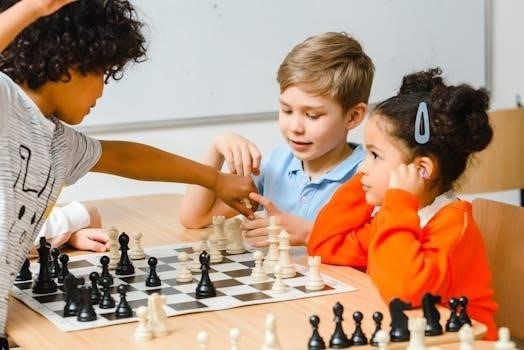The Whole-Brain Child⁚ Key Concepts
The Whole-Brain Child, co-authored by Daniel Siegel and Tina Bryson, introduces revolutionary strategies rooted in neuroscience. These concepts nurture a child’s developing mind. Key ideas involve understanding brain integration and promoting emotional resilience through practical techniques.
Understanding Brain Development
The Whole-Brain Child emphasizes the importance of understanding how a child’s brain develops to improve parenting approaches. The book explains the different parts of the brain and their functions, including the “upstairs brain” responsible for decision-making and emotional regulation, and the “downstairs brain,” which governs basic instincts and reactions. Understanding these functions is crucial for parents.
The book highlights that a child’s brain is still developing, particularly the connections between different regions. This developmental stage explains why children sometimes struggle with emotional control and logical thinking. By grasping these developmental processes, parents can better respond to their children’s behavior with empathy and understanding. Furthermore, the book suggests strategies to help integrate different parts of the brain.
These strategies include helping children connect emotionally with others and teaching them how to manage their emotions effectively. This approach promotes healthier brain development. Ultimately, understanding the basics of brain development enables parents to support their children’s growth in a more informed and nurturing way.

Strategies from “The Whole-Brain Child”
The Whole-Brain Child offers 12 revolutionary strategies designed to nurture a child’s developing mind. These techniques focus on integrating brain functions. They also promote emotional regulation, and improve communication between parent and child.
Integrating Left and Right Brain
One of the core strategies in The Whole-Brain Child involves integrating the left and right hemispheres of a child’s brain. The left brain is logical and analytical, focusing on language and reasoning. The right brain is more emotional and creative, dealing with nonverbal cues and feelings.
When children experience difficulties, it’s often because one side of their brain is dominating the other. For instance, a child overwhelmed by emotion (right brain) may struggle to articulate their feelings logically (left brain).
The book provides practical techniques to help children connect these two sides. Telling stories that incorporate both facts and feelings can bridge the gap. Encouraging children to describe their emotions and then analyze the situation helps them integrate left-brain logic with right-brain emotion. Activities that engage both creativity and reasoning, such as building with LEGOs or drawing diagrams, can also foster integration. By balancing these hemispheres, children develop more balanced responses and improved emotional regulation skills.
Engaging the Upstairs Brain
The Whole-Brain Child emphasizes the importance of engaging what the authors call the “upstairs brain,” which includes the prefrontal cortex. This part of the brain is responsible for decision-making, empathy, self-awareness, and emotional regulation. It’s not fully developed until the mid-twenties, so children often struggle with these skills.
The book offers strategies to help children access and strengthen their upstairs brain. One technique is to encourage thoughtful decision-making by asking questions that prompt reflection, rather than simply giving commands. Help them consider the consequences of their actions and explore different perspectives.
Mindfulness practices, such as deep breathing or focusing on the present moment, can also help children engage their upstairs brain. These practices promote self-awareness and emotional regulation. Furthermore, teaching empathy by discussing others’ feelings and perspectives strengthens their capacity for compassion and understanding. By consistently engaging the upstairs brain, parents help children develop crucial life skills and foster emotional intelligence.

Practical Applications for Parents
The Whole-Brain Child offers parents practical strategies to navigate challenging situations. It provides tools for connecting with their children emotionally and redirecting behavior effectively. These methods foster stronger relationships and support healthy brain development.
Connecting and Redirecting
Connecting with a child emotionally before attempting to redirect their behavior is a cornerstone of the strategies presented in The Whole-Brain Child. This involves acknowledging the child’s feelings and perspective, creating a sense of being understood and validated. When children feel heard, they are more receptive to guidance.
Redirecting, then, becomes a collaborative process rather than a power struggle. Parents can use techniques such as storytelling or engaging the child’s “upstairs brain” (the prefrontal cortex) to promote reasoning and problem-solving. By fostering a connection first, parents can help children integrate their emotions and actions, leading to more adaptive and positive outcomes.
This approach encourages empathy and understanding, transforming challenging moments into opportunities for growth and connection. It shifts the focus from simply controlling behavior to teaching children how to manage their emotions and make better choices, fostering resilience and emotional intelligence. Remember to connect before you redirect to help your child.
Naming Emotions to Tame Them
One powerful strategy highlighted in The Whole-Brain Child involves helping children identify and name their emotions. This technique, often referred to as “name it to tame it,” is based on the idea that verbalizing feelings can help to regulate them. When children can articulate what they are feeling, it allows their upstairs brain to engage, promoting a sense of control and understanding;
By providing children with the vocabulary to describe their emotions, parents empower them to process their experiences in a more constructive way. This could involve saying, “I see you’re feeling frustrated because you can’t reach the toy,” or “It sounds like you’re feeling sad that your friend can’t play today.”
This process encourages emotional awareness and helps children develop self-regulation skills. It transforms overwhelming feelings into manageable experiences. By naming emotions, children begin to understand that feelings are temporary and can be understood, ultimately fostering emotional resilience and a greater sense of self-awareness in the child.

Resources and Further Reading
For deeper insights, explore The Whole-Brain Child PDF for comprehensive strategies. Also, discover related works by Siegel and Bryson for continued learning on child development and effective parenting techniques, fostering a holistic understanding.
The Whole-Brain Child PDF Availability
Finding The Whole-Brain Child in PDF format allows for convenient access to its valuable insights. The PDF version enables readers to easily search, highlight, and annotate the text, enhancing their learning experience. Many online platforms offer the PDF for download, either for purchase or through library services.
When seeking a PDF copy, ensure it originates from a reputable source to avoid copyright infringement and ensure the content’s integrity. Official websites of the authors or publisher are reliable options. Additionally, educational institutions and online libraries may provide access to the PDF for their members or students.
The availability of The Whole-Brain Child as a PDF makes it accessible to a wider audience, allowing parents, educators, and caregivers to benefit from its strategies regardless of location or budget. It is a valuable resource for understanding child development and promoting healthy emotional growth. Remember to always check the legitimacy of the source before downloading any PDF files to protect yourself from potential malware or viruses. The digital format further facilitates sharing key concepts with others.
Related Works by Siegel and Bryson
Daniel Siegel and Tina Payne Bryson have collaborated on several impactful books that complement the principles outlined in The Whole-Brain Child. One notable work is No-Drama Discipline, which provides practical strategies for managing challenging behaviors without resorting to punishment or harsh tactics. This book emphasizes connection and understanding as key components of effective discipline.
Another related work is The Yes Brain Child, which explores how to cultivate resilience, curiosity, and emotional intelligence in children. This book offers guidance on fostering a “Yes Brain,” characterized by openness, engagement, and adaptability. These concepts build upon the brain integration strategies presented in The Whole-Brain Child, offering a more comprehensive approach to child development.
These books by Siegel and Bryson offer valuable insights and practical tools for parents and educators. They explore various aspects of child psychology, including emotional regulation, attachment, and resilience. By understanding these concepts, adults can create nurturing environments that support children’s growth and well-being. Their work is a valuable resource for anyone seeking to deepen their knowledge of child development and effective parenting strategies.

Criticisms and Considerations
While The Whole-Brain Child has garnered widespread praise, it’s essential to acknowledge some criticisms and considerations. Some critics argue that the book oversimplifies complex neurological processes. They suggest that the brain is far more nuanced than the “left brain/right brain” dichotomy presented. Additionally, some find the strategies too prescriptive, potentially neglecting the individuality of each child and family dynamic.
Another consideration is the book’s emphasis on parental involvement. While parental engagement is crucial, not all parents have the time, resources, or emotional capacity to implement the strategies consistently. This may lead to feelings of guilt or inadequacy for some caregivers. Furthermore, the book primarily focuses on neurotypical development, potentially overlooking the unique needs of children with neurodevelopmental differences.
Despite these criticisms, The Whole-Brain Child offers valuable insights into child development and effective parenting strategies. However, it is crucial to approach the book with a critical eye, recognizing its limitations and adapting the strategies to fit individual circumstances. Parents should view the book as a guide rather than a rigid set of rules, trusting their instincts and tailoring their approach to meet their child’s specific needs.
